Archives
-
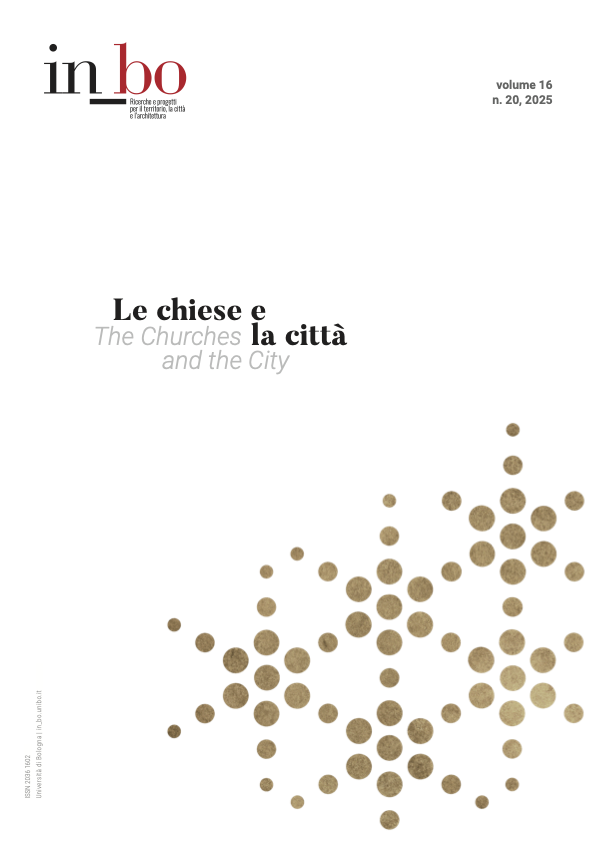 Vol. 16 No. 20 (2025)The Churches and the City
Vol. 16 No. 20 (2025)The Churches and the CityEdited by Luigi Bartolomei (University of Bologna), Gianluca Buoncore (Univerisità degli Studi di
Firenze), Federica Fuligni (Indipendent researcher), Danilo Manzo (Centro Studi "C. Ghirardacci")
The Volume aims to analyze the relationship between churches and the city in the reconstruction
plans, in the phases of urbanization, in the cultural debate on the role of religious buildings
and their image after the Second Vatican Council, and in the precursor movements in different
European contexts.
Within a reflection on the future of this relationship, in the context of radical changes in the social
structure, in the acceleration between secularization and post-secularization, in the final distinction
between civil community and religious community, the authors draw a path for possible form, role
and model for churches of today and tomorrow. -
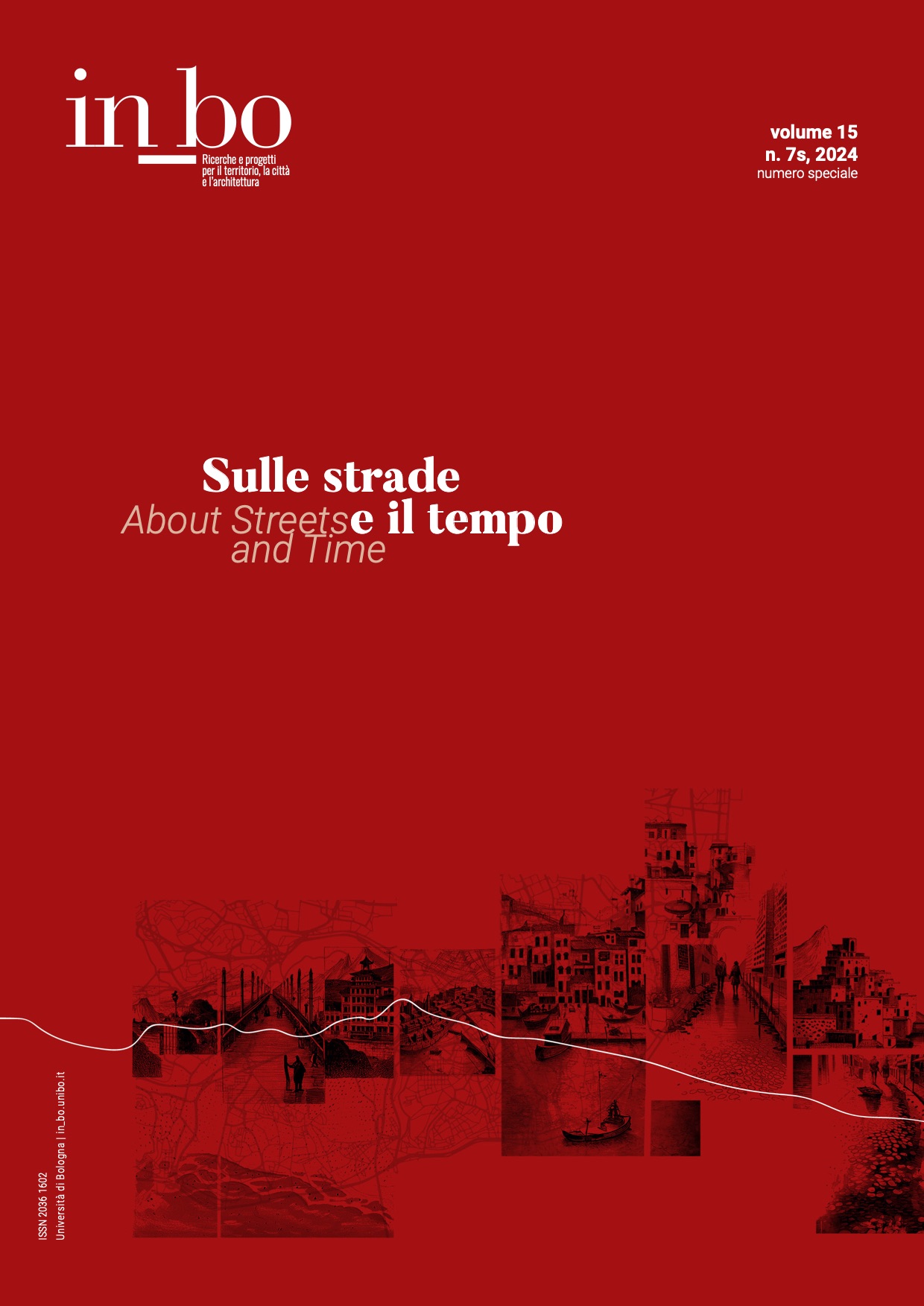 Vol. 15 No. 7s (2024)About Streets and Time
Vol. 15 No. 7s (2024)About Streets and TimeEdited by Sérgio Barreiros Proença (Lisbon School of Architecture, Universidade de Lisboa, Portugal), Francesca Dal Cin (Lisbon School of Architecture, Universidade de Lisboa, Portugal), Alessia Allegri (Lisbon School of Architecture, Universidade de Lisboa, Portugal), Luís Miguel Ginja (Lisbon School of Architecture, Universidade de Lisboa, Portugal)
In “About Streets and Time,” a rich tapestry of critical and interdisciplinary reflections is delineated with the aim of decoding the contemporary significance of public space and its physical, political and social declinations. The street, in all its different forms, names and meanings, encloses the distinctive characteristics of the community it inhabits, offering insights into the historical, social and cultural narratives that shape its identity. This issue of in_bo presents the most recent researches on the concept of the Time of Streets, addressing multiple interpretations, from semantics to urban morphology, from history to collective memory, highlighting that understanding the cycles and rhythms that create the wrinkles of the city is fundamental to imagining and designing the future of streets.
-
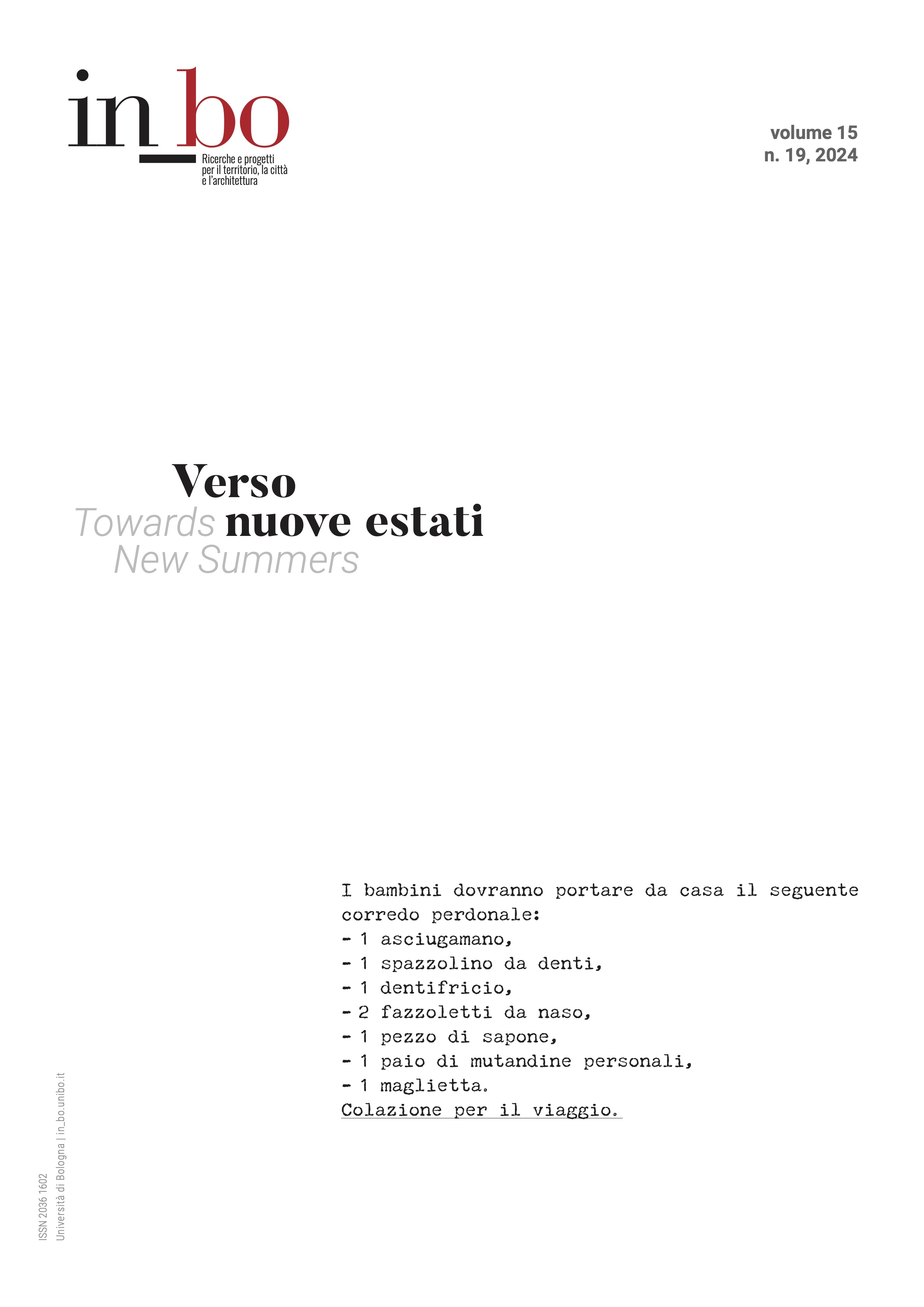 Vol. 15 No. 19 (2024)Towards New Summers: Past, Present, and Future of Holiday Camps in Europe
Vol. 15 No. 19 (2024)Towards New Summers: Past, Present, and Future of Holiday Camps in EuropeEdited by Sofia Nannini (Politecnico di Torino).
In Italy alone, dozens of abandoned holiday camps for children are scattered throughout the landscape. The size and diffusion of this heritage calls for a scientific debate on the history and future of these buildings, which are often in a state of serious decay. From Alpine valleys to coastlines, former holiday camps for children tell a long story of educational, architectural, health and social experimentation, which has influenced generations of Europeans in the last 150 years. Holiday camps were hosted in traditional or modern structures, built from long-lasting materials such as reinforced concrete or temporary camping tents. Whatever their nature, holiday camps have left both physical and intangible traces on the European landscape and society. With this issue, in_bo engages in a debate on the history of holiday camps in Europe between the nineteenth and twentieth centuries, with particular consideration of contemporary reuse and restoration strategies of this architectural heritage.
-
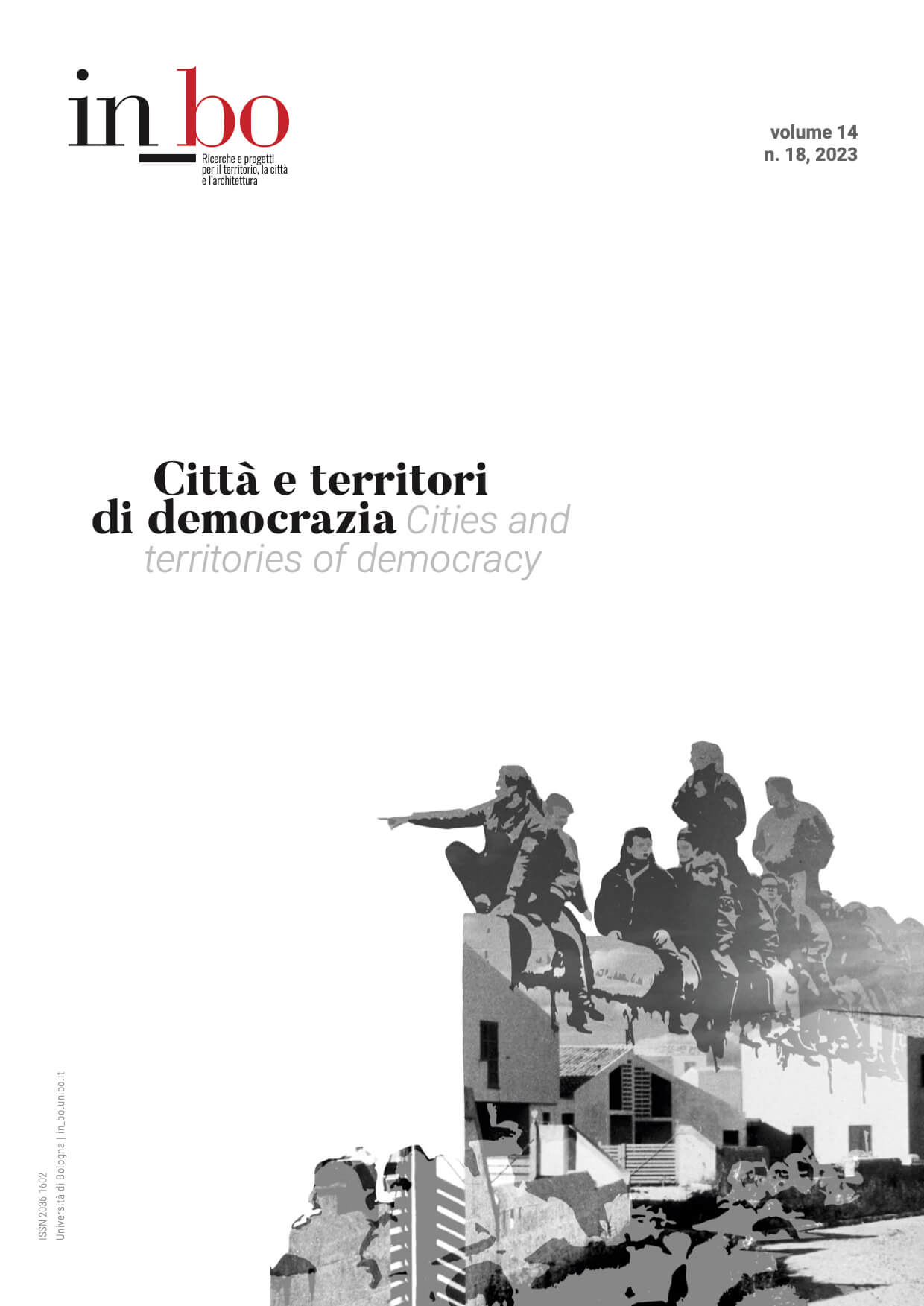 Vol. 14 No. 18 (2023)Cities and Territories of Democracy
Vol. 14 No. 18 (2023)Cities and Territories of DemocracyThe connection between the forms of power exercise and those of space must be under continuous observation. In a co-evolutionary ecosystem, where local societies transform (and transform themselves with) the environments in which they live, a perturbation in the ways of living and producing eventually also perturbs forms of governance, and vice versa. In this process of becoming and con-being, the condition for safeguarding democracy is the protection of what we define here as democratic cities and territories, of which we have collectively attempted to circumscribe the meaning, character and limits. Whether they are real or utopian expressions, an observation or a desire; whether there are models for implementing them; whether there are parameters that identify their democratic nature; whether an aesthetic characterises them: we attempt to answer these questions in this issue of the journal in_bo edited by Ilaria Agostini, Luigi Bartolomei and Elena Franco.
-
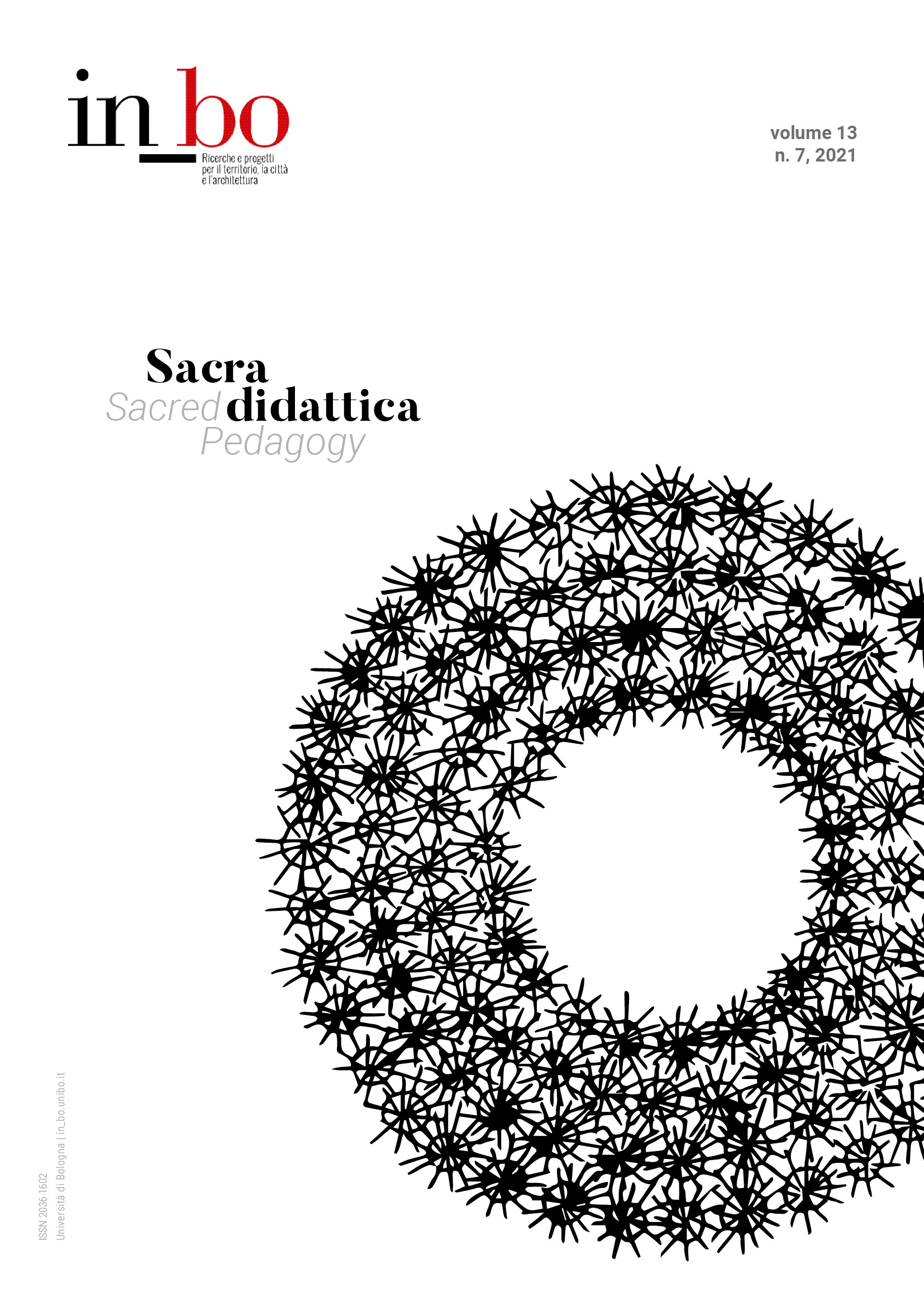 Vol. 13 No. 17 (2022)Sacred Pedagogy: The Sacred in Architectural and Design Education
Vol. 13 No. 17 (2022)Sacred Pedagogy: The Sacred in Architectural and Design Educationin_bo vol. 13 no. 17 focuses on one of its main themes of interest – the sacred – and investigates it according to the relationship between sacred architecture and design pedagogy in contemporary schools of architecture. Conceived in collaboration with Frate Sole Foundation (Pavia) and edited by Luigi Bartolomei and Andrea Conti, the issue draws a reflection from the sacred understood as the object of highest expression in architectural projects, to the intrinsic relationship between design pedagogy and sacred, intended as a complex of rituals that constitutes the educational practices in architecture. Authors’ contributions span from case studies of design studios to theoretical reflections, and analysis of educational and professional practices of architects and artists.
-
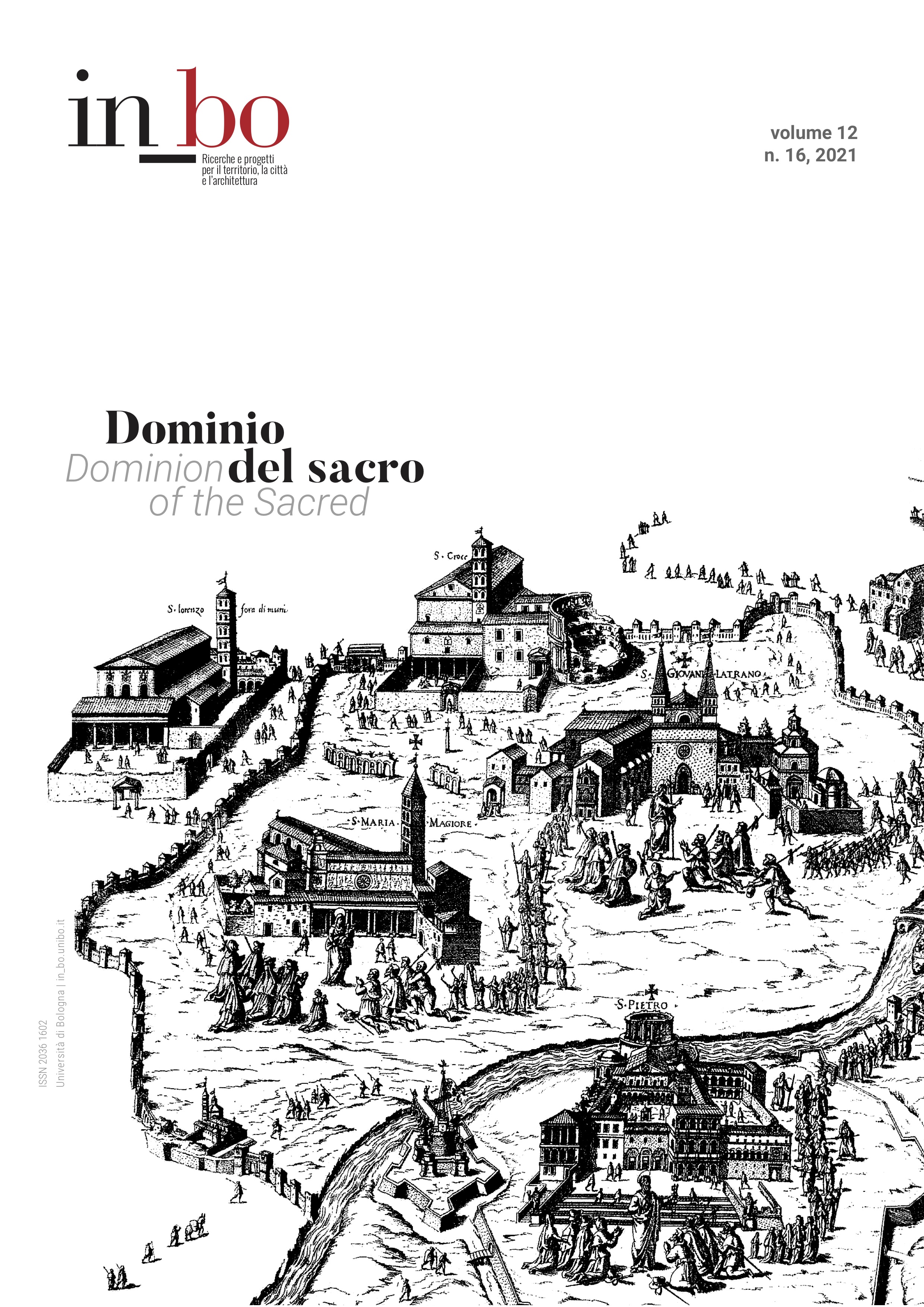 Vol. 12 No. 16 (2021)Dominion of the Sacred: Image, Cartography, Knowledge of the City after the Council of Trent
Vol. 12 No. 16 (2021)Dominion of the Sacred: Image, Cartography, Knowledge of the City after the Council of TrentEdited by Mario Bevilacqua (Università degli Studi di Firenze) e Marco Folin (Università di Genova).
Between the sixteenth and seventeenth centuries, the Italian political geography was polarized by a number of cities of different sizes and traditions: Rome and Florence, Milan and Naples, Genoa and Venice, Turin and Modena, either ancient republics or new dynastic capitals, satellites of the great European monarchies or small Signorias. The conjunction — less frequently the conflict — between the mandates of the Council of Trent and the interests of the ruling élites of those cities set the foundation for novel forms of social, cultural and spiritual control, fostering new urban structures and policies, deeply conditioned by the presence and government of the sacred. Prominent issues at the time were the widespread presence of male religious orders and cloistered female orders, the renewed role played by the residing diocesan curias, the parishes with their activities of social recording and control, the stabilization of the confraternities, the construction of places of worship, and the emergence of devotional practices.
-
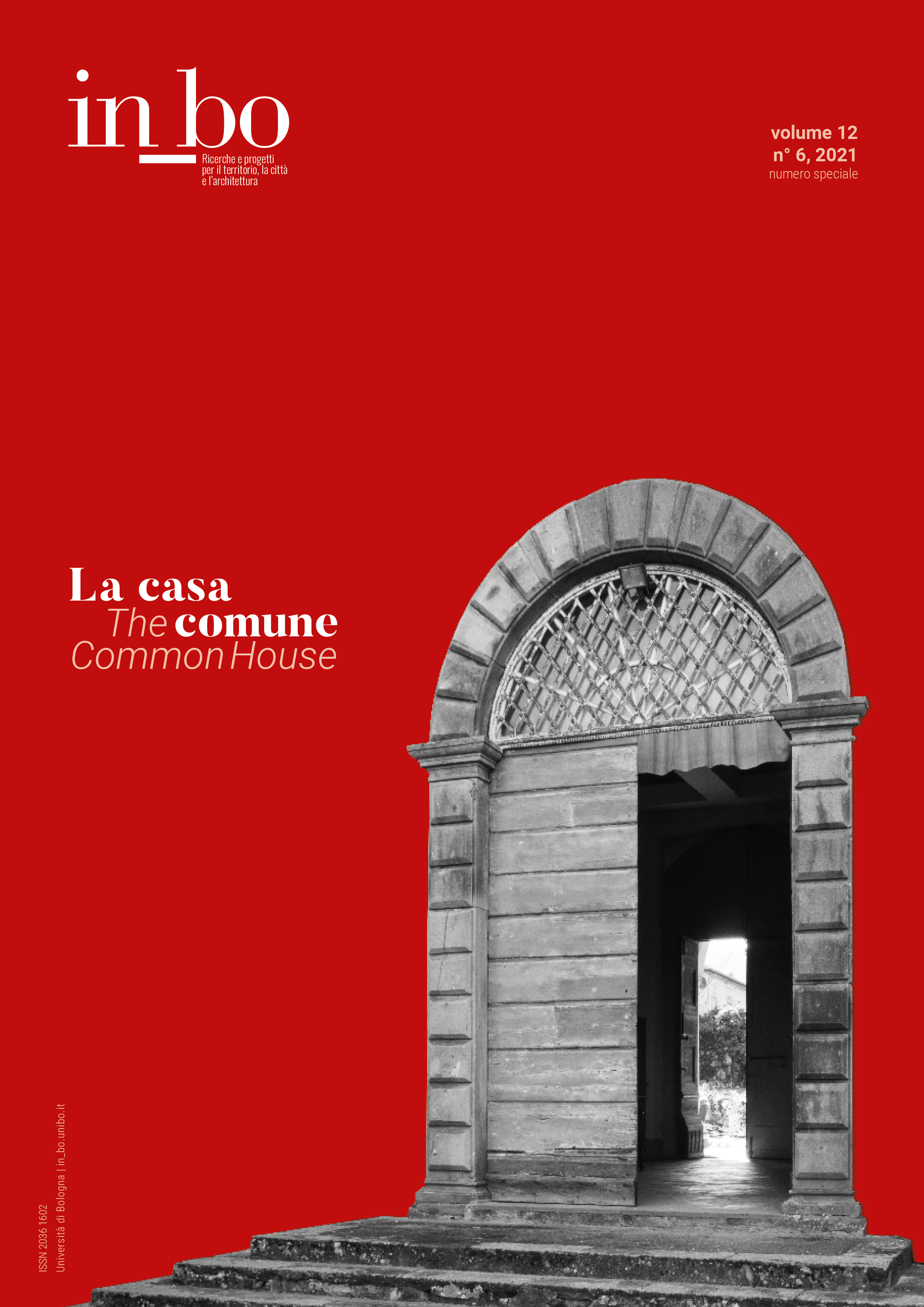 Vol. 12 No. 6 (2021)The Common House: New Scenarios for Abandoned Monastic Heritage
Vol. 12 No. 6 (2021)The Common House: New Scenarios for Abandoned Monastic Heritagein_bo vol. 12, no. 6 brings together the proceedings of the summer school "New Scenarios for Abandoned Monastic Heritage" held in Lucca between July, 25th and August, 3rd 2019. The summer school was promoted by the Department of Architecture of the University of Bologna, Centro Studi Cherubino Ghirardacci, Scuola Alti Studi Lucca IMT and by the Augustinian community of the Corpus Domini monastery in Cento. Edited by Luigi Bartolomei and Sofia Nannini, the issue collects essays and talks on abandoned monastic heritage that are intertwined with architecture, religion, law, economy, history and art.
-
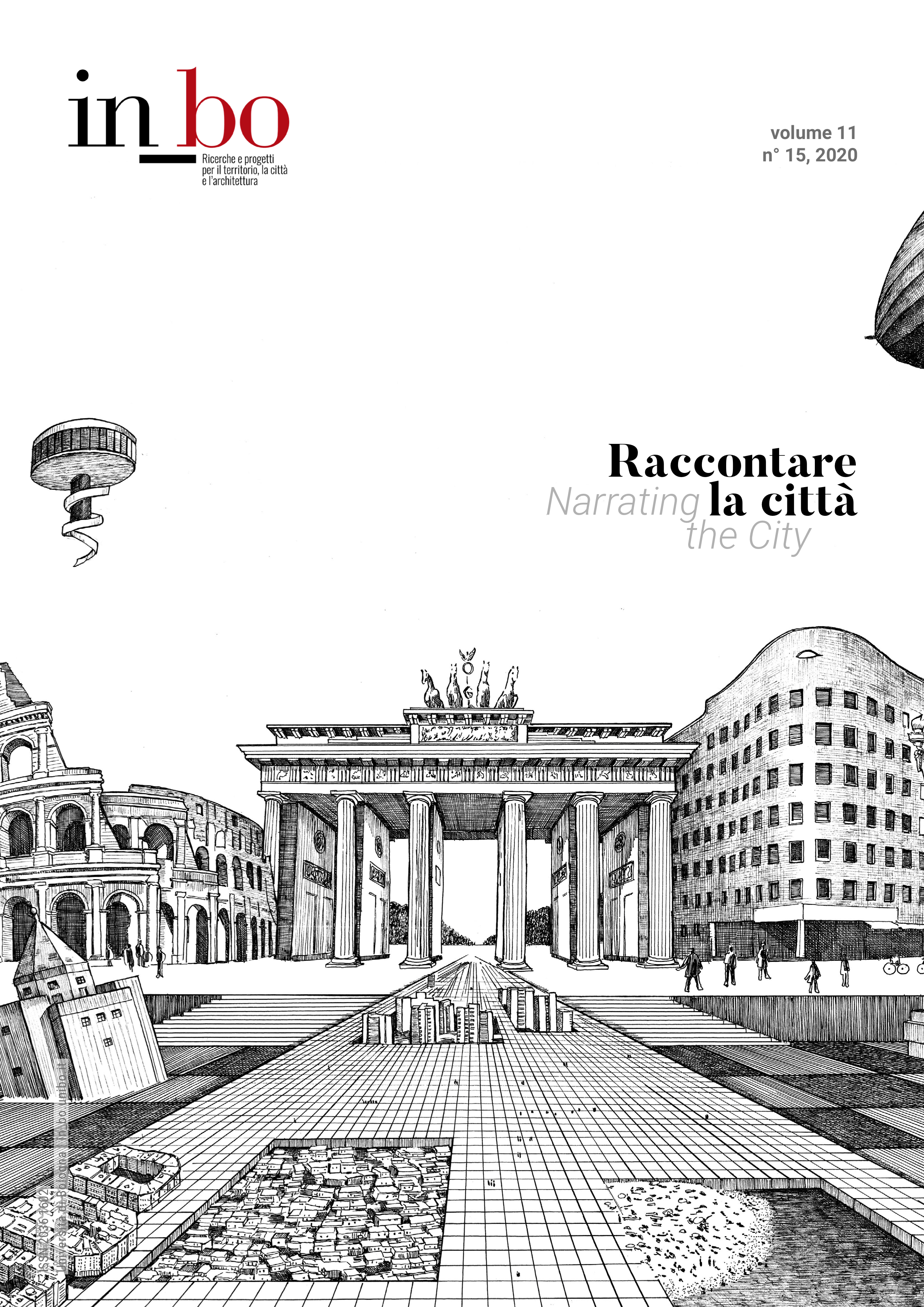 Vol. 11 No. 15 (2020)Narrating the Cityin_bo vol. 11, no. 15 focuses on the relationship between narratives and cities, investigating the current role of narratives as a tool and their ability to support urban practices. The contents of the issue range from short invited essays, scientific articles and visual works, with the purpose to explore and to trace new trajectories on which to base the future of the relationship between architectural design, narratives and urban phenomena. The issue is edited by Michele F. Barale and Matteo Vianello.
Vol. 11 No. 15 (2020)Narrating the Cityin_bo vol. 11, no. 15 focuses on the relationship between narratives and cities, investigating the current role of narratives as a tool and their ability to support urban practices. The contents of the issue range from short invited essays, scientific articles and visual works, with the purpose to explore and to trace new trajectories on which to base the future of the relationship between architectural design, narratives and urban phenomena. The issue is edited by Michele F. Barale and Matteo Vianello. -
 Vol. 11 No. 5 (2020)Architecture Today
Vol. 11 No. 5 (2020)Architecture TodayChanges on the Role of the Designer and on the Architectural Education. Special issue.
-
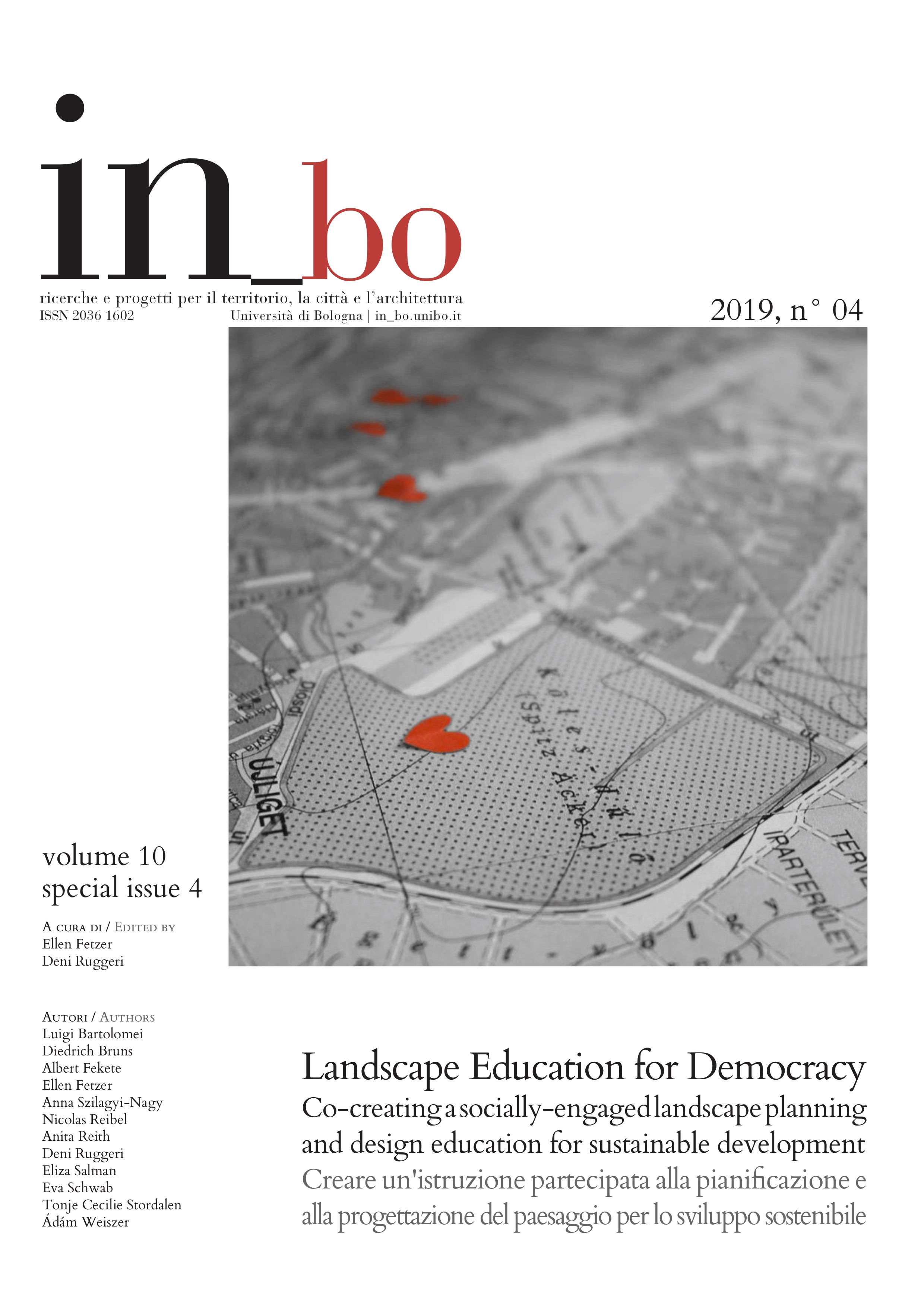 Vol. 10 No. 4 (2019)Landscape Education for Democracy
Vol. 10 No. 4 (2019)Landscape Education for DemocracyLandscape Education for Democracy. Co-creating a socially-engaged landscape planning and design education for sustainable development. Special issue edited by Ellen Fetzer and Deni Ruggeri.
-
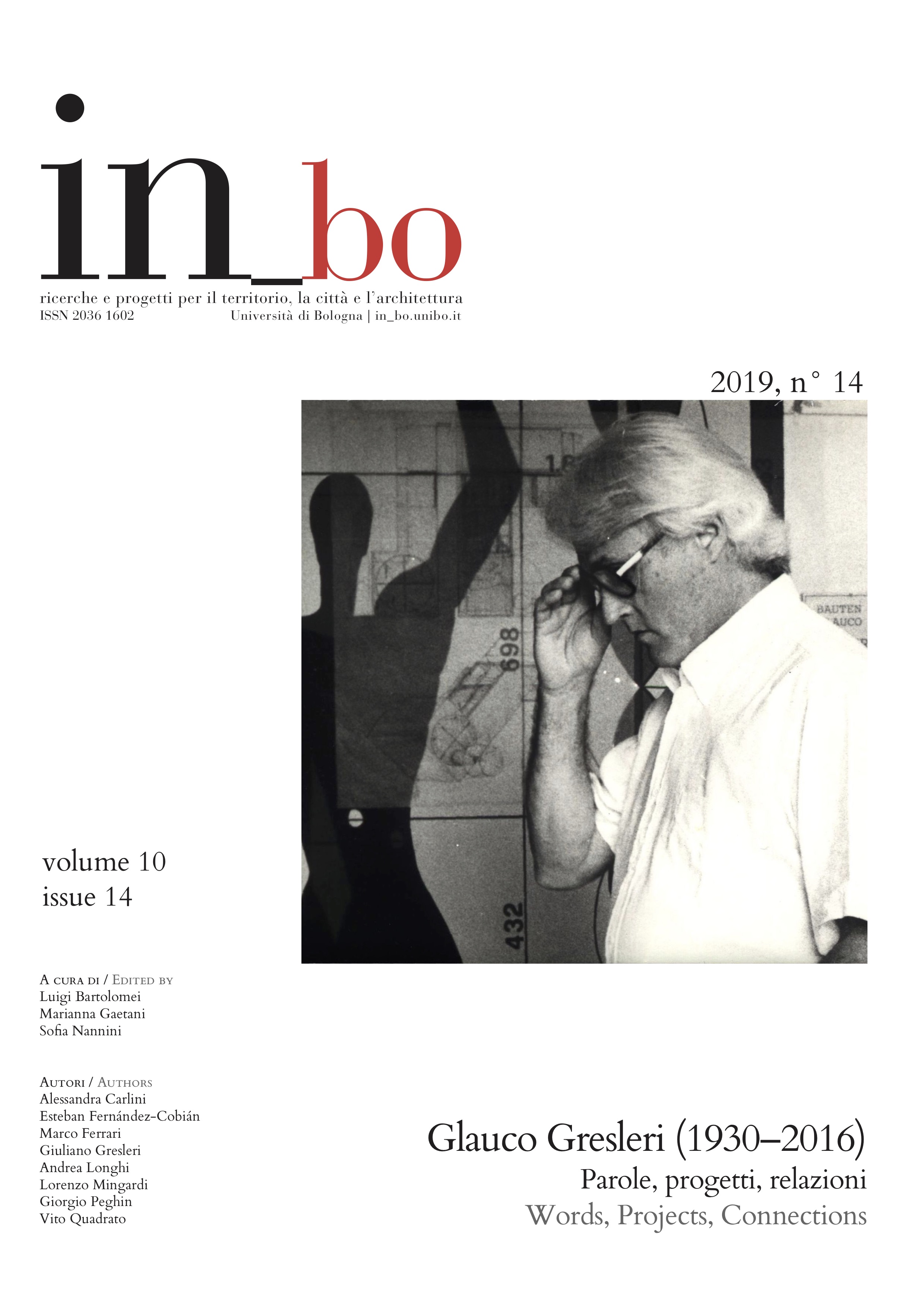 Vol. 10 No. 14 (2019)Glauco Gresleri (1930–2016). Words, Projects, Connections
Vol. 10 No. 14 (2019)Glauco Gresleri (1930–2016). Words, Projects, ConnectionsMonographic issue on the life and work of Glauco Gresleri. Edited by Luigi Bartolomei, Marianna Gaetani and Sofia Nannini.
-
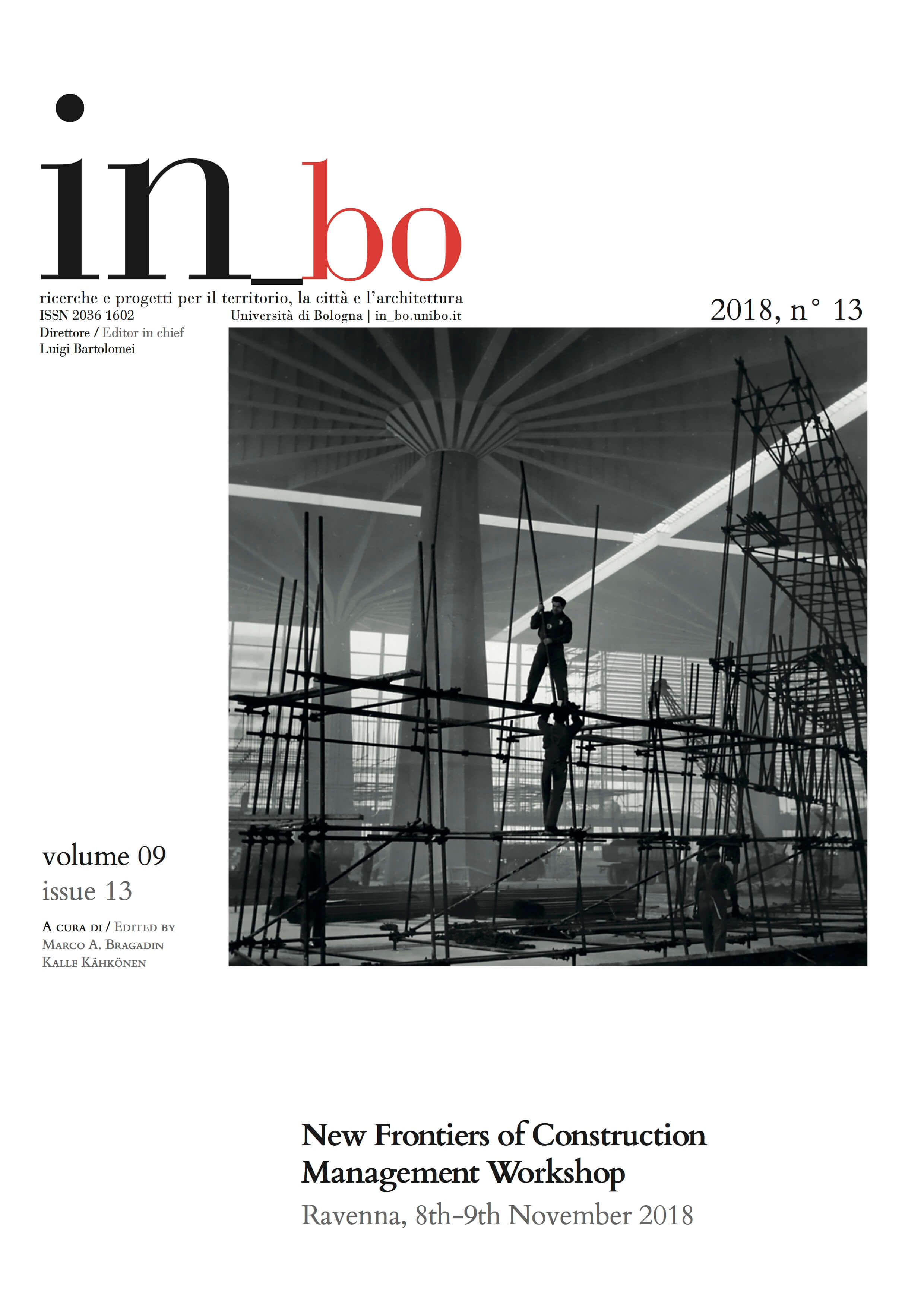 Vol. 9 No. 13 (2018)New Frontiers of Construction Management Workshop
Vol. 9 No. 13 (2018)New Frontiers of Construction Management WorkshopProceedings of the New Frontiers of Construction Management Workshop in Ravenna, 8–9 November 2018. Edited by Marco A. Bragadin and Kalle Kähkönen.
-
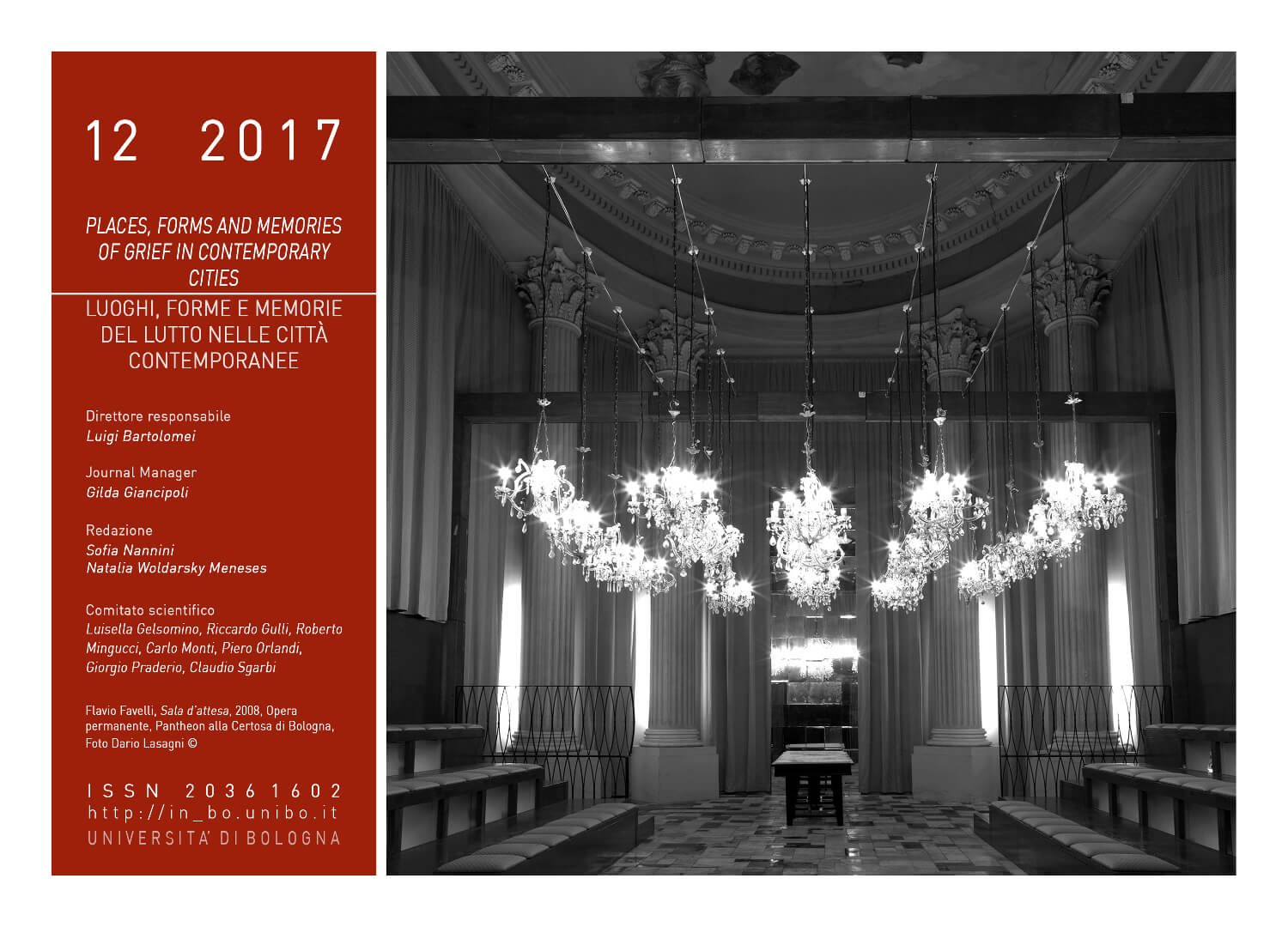 Vol. 8 No. 12 (2017)Places, Forms and Memories of Grief in Contemporary Cities
Vol. 8 No. 12 (2017)Places, Forms and Memories of Grief in Contemporary CitiesProceedings of the symposium "Places, Forms and Memories of Grief in Contemporary Cities", Ravenna, 25-27 October 2017. Edited by Luigi Bartolomei.
-
 Vol. 8 No. 11 (2017)THE FUTURE OF CHURCHES: LANDSCAPES
Vol. 8 No. 11 (2017)THE FUTURE OF CHURCHES: LANDSCAPESProceedings of the symposium The Future of Churches, Bologna, 5–7 October 2016, vol. 2. Edited by Luigi Bartolomei.
-
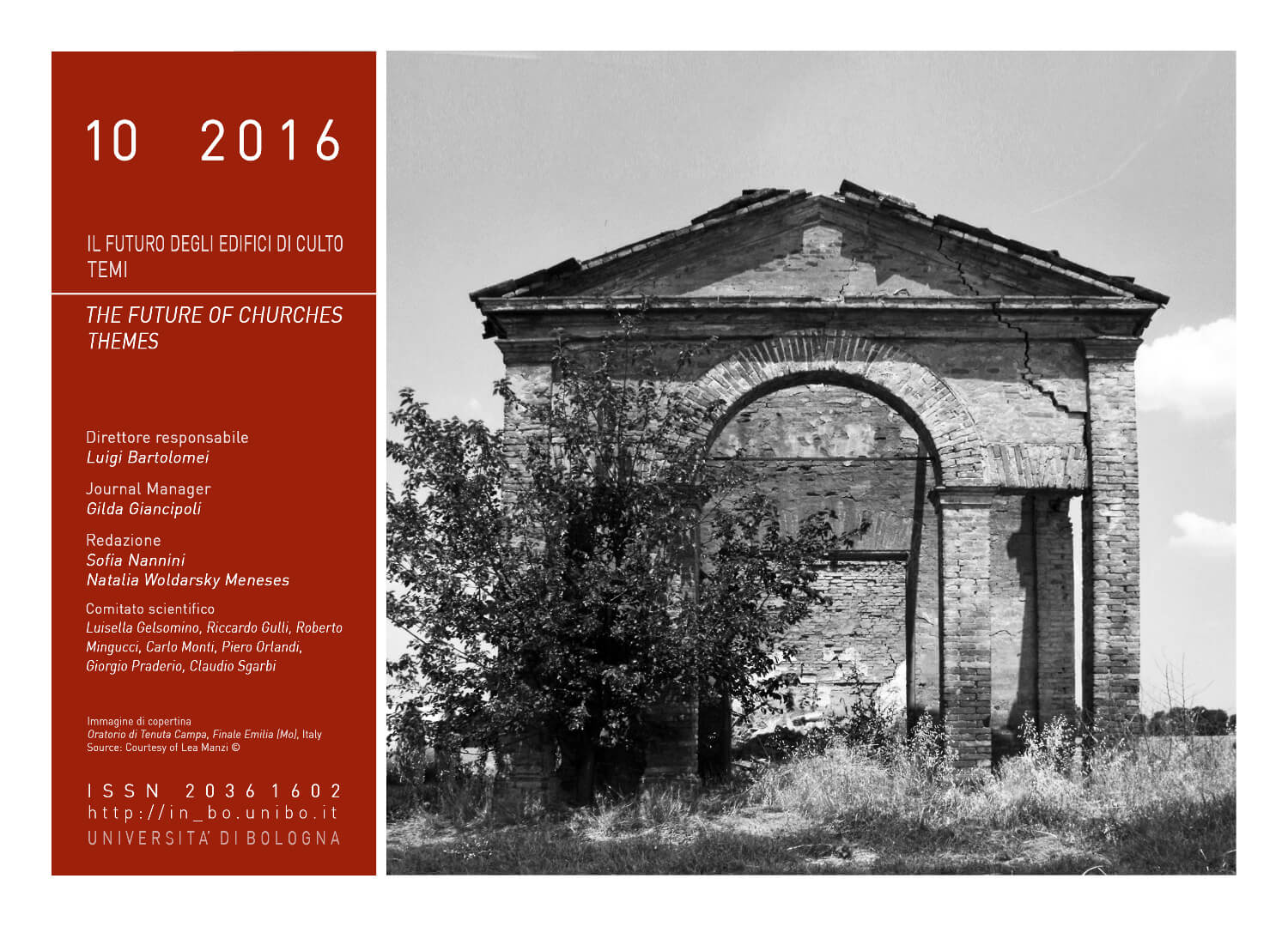 Vol. 7 No. 10 (2016)THE FUTURE OF CHURCHES: THEMES
Vol. 7 No. 10 (2016)THE FUTURE OF CHURCHES: THEMESProceedings of the symposium The Future of Churches, Bologna, 5–7 October 2016, vol. 1. Edited by Luigi Bartolomei.
-
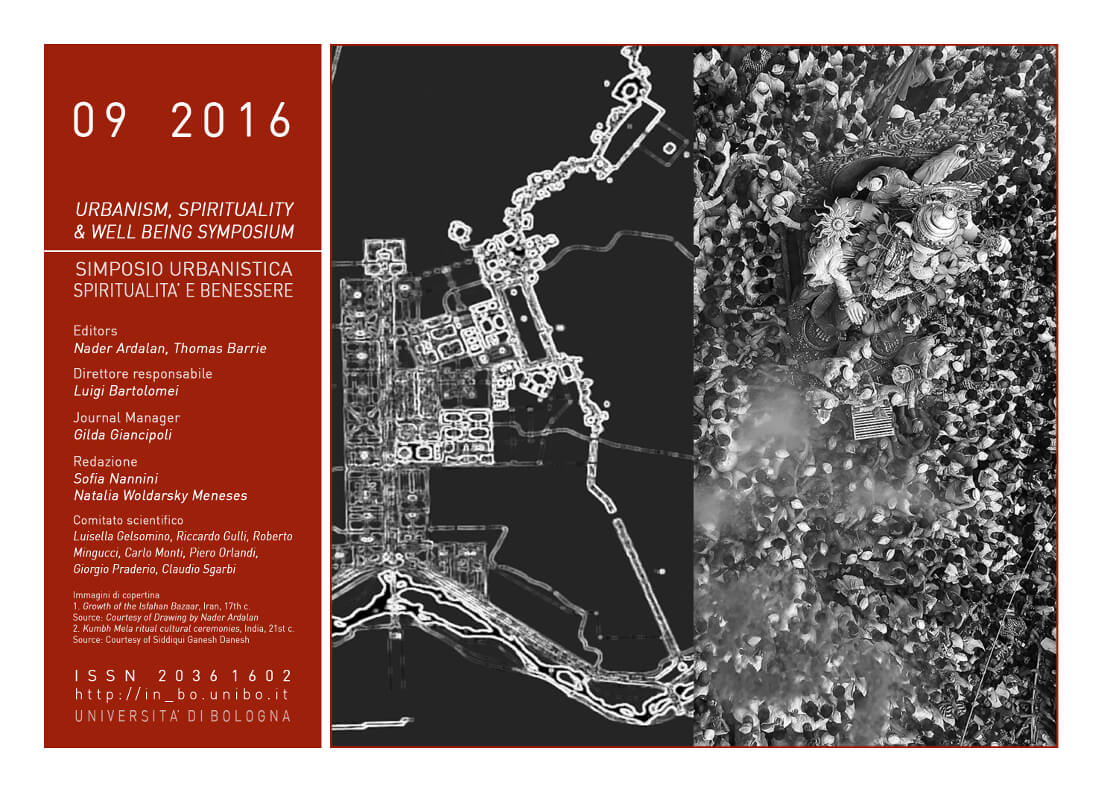 Vol. 7 No. 9 (2016)URBANISM, SPIRITUALITY & WELL BEING SYMPOSIUM
Vol. 7 No. 9 (2016)URBANISM, SPIRITUALITY & WELL BEING SYMPOSIUMProceedings of the symposium Urbanism, Spirituality & Well Being, edited by Nader Ardalan and Thomas Barrie.
-
 Vol. 6 No. 8 (2015)CITY OF THE DEAD / CITY OF THE LIVING
Vol. 6 No. 8 (2015)CITY OF THE DEAD / CITY OF THE LIVINGProceedings of the first international symposium on funerary architectur City of the dead / City of the living, Ravenna, 22–24 October 2015. Edited by Luigi Bartolomei.
-
 Vol. 6 No. 3 (2015)TEACHING AND MAKING ARCHITECTURE TODAY. A global inquiry, special issue
Vol. 6 No. 3 (2015)TEACHING AND MAKING ARCHITECTURE TODAY. A global inquiry, special issueSpecial issue on teaching and making architecture, edited by Luigi Bartolomei and Gilda Giancipoli.
-
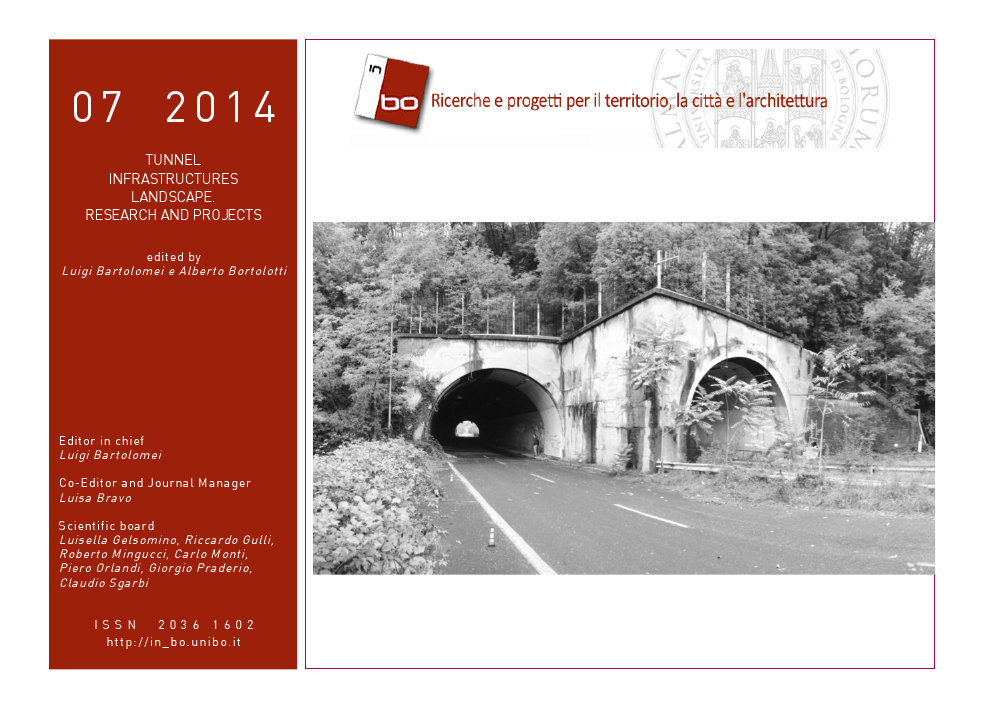 Vol. 5 No. 7 (2014)TUNNEL INFRASTRUCTURES LANDSCAPE. Research and projects
Vol. 5 No. 7 (2014)TUNNEL INFRASTRUCTURES LANDSCAPE. Research and projectsTunnel Infrastructures Landscape. Edited by Luigi Bartolomei and Alberto Bortolotti.
-
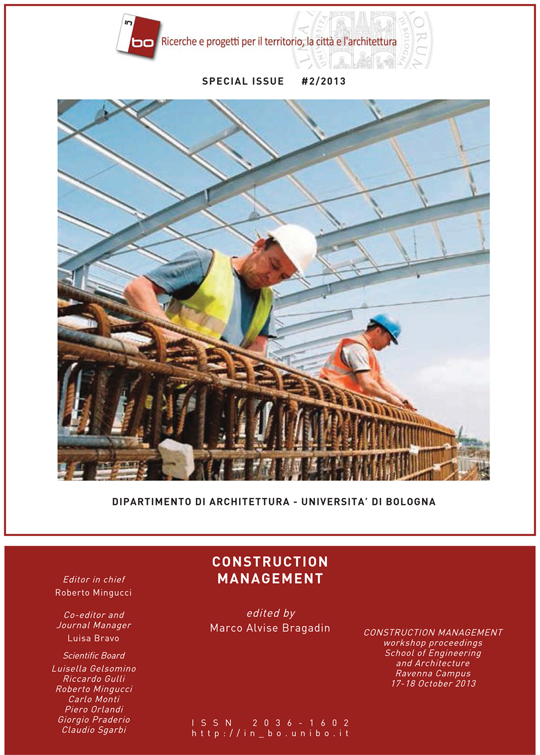 Vol. 4 No. 2 (2013)CONSTRUCTION MANAGEMENT, special issue
Vol. 4 No. 2 (2013)CONSTRUCTION MANAGEMENT, special issueProceedings of the Construction Management Workshop, Ravenna, 17–18 October 2013, promoted by the School of Engineering and Architecture at Ravenna Campus, University of Bologna, with the support of the Department of Architecture in Cesena, of the Fondazione Flaminia in Ravenna and of the Scuola Superiore di studi sulla città e il territorio in Ravenna. Edited by Marco Alvise Bragadin.
-
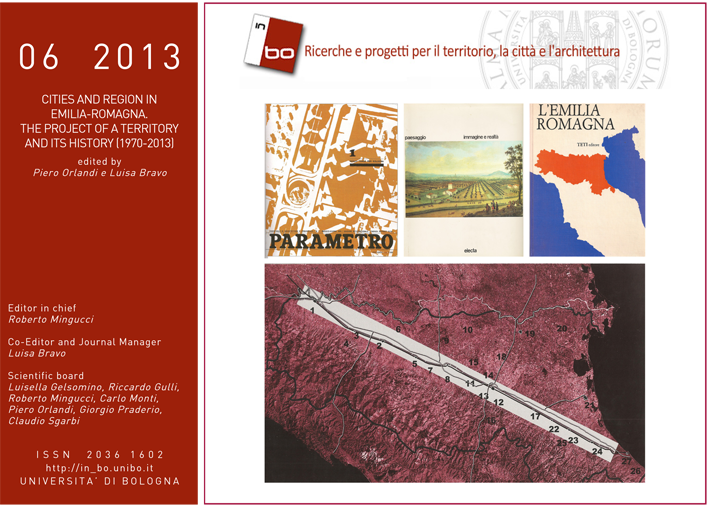 Vol. 4 No. 6 (2013)CITIES AND REGION IN EMILIA-ROMAGNA. The project of a territory and its history (1970-2012)
Vol. 4 No. 6 (2013)CITIES AND REGION IN EMILIA-ROMAGNA. The project of a territory and its history (1970-2012)The issue, edited by Piero Orlandi and Luisa Bravo, is devoted to review the theoretical arguments, the discussion, the rules and the most significant cases that have influenced the planning activity of the Emilia-Romagna Region by the constitution of the regional institution, from 1970 to present.
The issue was developed in collaboration with the Institute of Cultural Heritage of the Emilia-Romagna Region, as a part of a research agreement signed in 2013 with the Department of Architecture, University of Bologna.
-
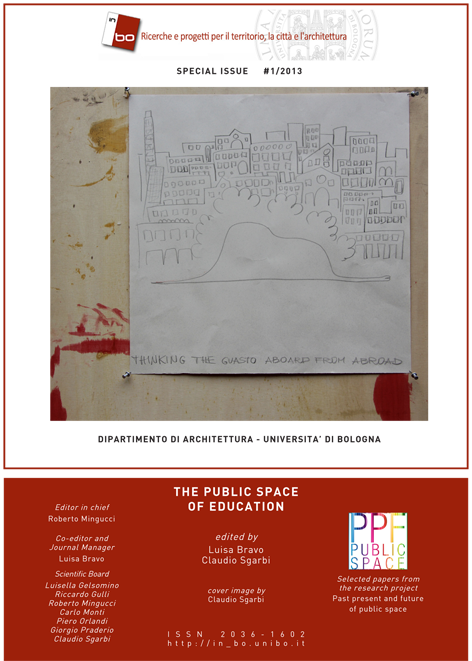 Vol. 4 No. 1 (2013)THE PUBLIC SPACE OF EDUCATION, special issue
Vol. 4 No. 1 (2013)THE PUBLIC SPACE OF EDUCATION, special issueThe word “public” and the word “education” share a common sense. Usually an educate person knows how to behave in public.
The title of this special issue of IN_BO. Ricerche e progetti per il territorio, la città e l'architettura is pretentious but its contents are simply honest. They demonstrate different attempts made by very different scholars and students to fathom the territory of public space from different directions.This selection is not casual but it was not planned in advance. It is an encompassing meeting of complementary differences. We believe that the idea of persona, the duration of memory, the fragmentation of form, the experience of the senses, the notion of community, the plurality of identities and the image of the body, constitute a basic set of notions in the maieutic education of the public space.
This special issue of IN_BO. Ricerche e progetti per il territorio, la città e l'architettura explores possible, critical paths and approaches for understanding and designing public spaces, presenting and discussing projects developed in academic courses, in Italy (University of Florence), Israel (Bezalel Academy of Arts and Design), Canada (Azrieli School of Architecture and Urbanism), USA (University of California, Berkeley), Australia (Queensland University of Technology, Brisbane), China (The Chinese University of Hong Kong). These scholars joined, at the end of 2012, to the “Past present and future of public space” international project, developed at the University of Bologna, with the support of the “City Space Architecture” cultural association. The project aims to discuss the complex issue of public space through time, trying to find a new innovative approach in city understanding, in a multidisciplinary field of action, from morphological design derived from the tradition to emerging trends of the contemporary dimension.
First results of project activities will be presented, exhibited and discussed at the “Biennale dello spazio pubblico” national conference, promoted by the Italian National Institute of Urban Planners (INU), to be held in Rome, Italy, on May 18th at the Faculty of Architecture Roma TRE. The project will be developed throughout 2013. A call for papers will be launched at the Biennale session, through the web site of City Space Architecture (www.cityspacearchitecture.org) inviting scholars, architects, public administrators, artists and designers to contribute with their ideas and proposals in the pursuit of this challenging task. A final event is expected to take place on June/July 2014.
With our work we hope to give a meaningful and valuable response.Special issue edited by Luisa Bravo and Claudio Sgarbi
-
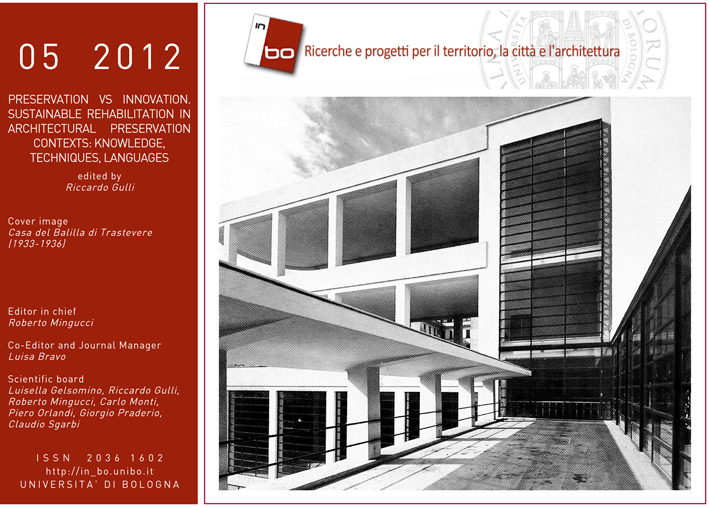 Vol. 3 No. 5 (2012)PRESERVATION VS INNOVATION
Vol. 3 No. 5 (2012)PRESERVATION VS INNOVATIONThe theme of the preservation of the characteristics of protected architectural heritage must nowadays be correlated to new requirements for the adaptation of existing buildings to performance standards. This subject raises new questions about the theoretical assumptions and tools to be adopted to coherently answer that request. Focusing on the theme of energy requalification of heritage buildings - the primary focus of interest for the reduction of pollution emissions, according to Horizon 2020 objectives - the preservation of the meanings of an architecture work and of its linguistic, typological and material characteristics proofs to be essential for protection interventions on buildings. However this can’t be considered exhaustive, as the raised issue necessarily requires to be further addressed within the speculative domain of Technique, or rather to open out to the contribution that innovation processes and methods belonging to the field of scientific knowledge could offer.
In this context, our reflection is oriented towards new research frameworks, in which both theory and practice of Architecture disciplines – from the historical and critic readings up to the technical intervention tools – as well as the analytic and instrumental analyses typical of the Building Engineering coexist, with the aim of returning a coherent approach to sustainability through proper preservation, fruition and enhancement of heritage building.The e-journal "IN_BO. Ricerche e progetti per il territorio, la città e l'architettura" adopts a system of selection based on blind peer-review.
Sincere thanks to the reviewers of the issue 5/2012 (in alphabetical order): Prof. Carlo Cecere, Prof. Alessandro Greco, Prof. Riccardo Gulli, Prof.ssa Raffaella Lione, Prof. Renato Morganti, Prof. Antonello SannaEdited by Riccardo Gulli
-
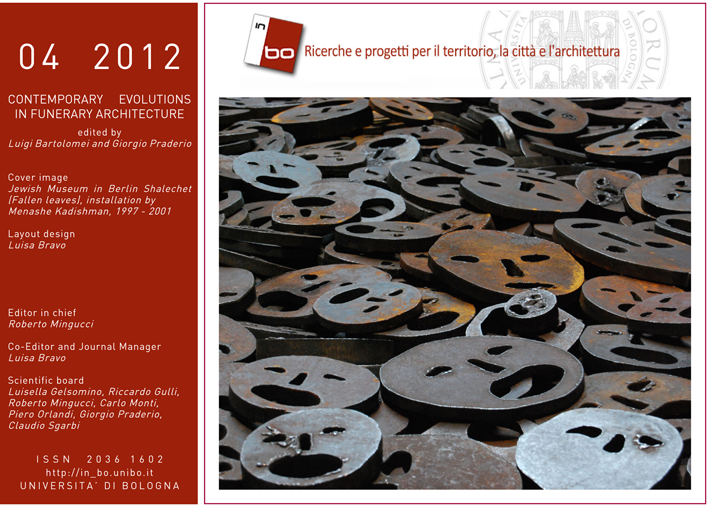 Vol. 3 No. 4 (2012)CONTEMPORARY EVOLUTIONS IN FUNERARY ARCHITECTURE
Vol. 3 No. 4 (2012)CONTEMPORARY EVOLUTIONS IN FUNERARY ARCHITECTUREThis issue of the journal is the collection of the proceedings from the conference “TANEXPLORA 2012 – Contemporary evolutions in funerary architecture", which took place on March 2012 in Palazzo Re Enzo, Bologna (http://www.tanexplora.it/index.html?id=13&lng=1). This experience concludes an intensive season of work and research on the “sacred space” of death and dying developed by the department of Architecture of the University of Bologna. The research is situated within the field of sacred spaces and rituals in the contemporary city. In the extremely fragile and fragmented sphere of current spirituality, spaces for grieving and associated rituals have proved to be a most pressing issue in order to understand the fluctuations and the needs of contemporary spirituality, its prevailing architectural manifestation and the spacial variety for its rituals.
Funeral homes and other mourning spaces are in fact a common epi-phenomenon of sacred space, representing the celebration of a passage from life to death which deserves a time (and therefore a space) for expressions of sorrow and affection that connect the proximity of a human dimension with that of a ritualistic one present even in new lay rituals.
Both the affective dimension of mourning and the liturgical and ritual one require a proper spatial development and are therefore an architectural theme.Edited by di L. Bartolomei e G. Praderio
-
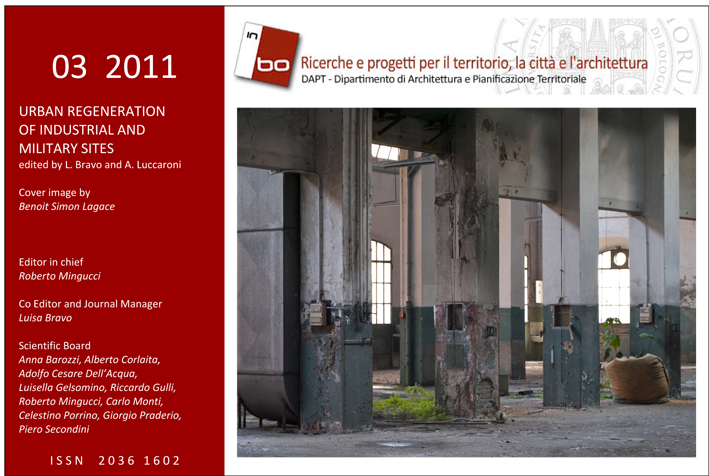 Vol. 2 No. 3 (2011)URBAN REGENERATION OF INDUSTRIAL AND MILITARY SITES
Vol. 2 No. 3 (2011)URBAN REGENERATION OF INDUSTRIAL AND MILITARY SITESIssue 3/2011 of "IN_BO. Ricerche e progetti per il territorio, la città e l’architettura" is about urban regeneration of areas subject to disposal of industrial and military activities, by presenting the results of researches, design studios and graduation thesis, and of an international workshop.
The issue is divided in two parts.
In the first part, in the "Urban and Territorial Planning" section, the issue introduces the topic of urban regeneration, from the perspective of the designer (Parmeggiani) and an explanation of the methodological approach (Minghini).
In the "Cities" section, four case studies are proposed: Bologna, with the sustainable regeneration of the Sani-Casaralta area, located in the outskirts (Ferrante, Bettazzi), Piacenza, with its vast heritage of military real estate (Milani), Forlì, with the redevelopment of a former monastery turned to military uses (Castagnoli) and Balangero, with environmental and landscape restoration of a large industrial site, a former asbestos mine (Giacobazzi). Four different levels of intervention, four different design settings.
In the "Architecture" section two projects are presented: the architectural rehabilitation of Capo Spartivento lighthouse, a former military garrison (Bartolomei) and the proposed temporary structures for commercial outlets, as an occasion for the increase in value of brownfield sites (Gaiti).In the second part, in the "Urban Design" section, the issue presents the results of the design workshop on the area Staveco redevelopment in Bologna, which took place from 15 January to 15 April 2011 at the Urban Center Bologna (Evangelists), promoted by Carleton University (Ottawa, Canada), Directed Studies Abroad Program in Architecture Master of the Azrieli School of Architecture and Urbanism (Sgarbi), with the participation of students from the University of Bologna, Degree Course in Architectural Engineering (Bravo, Ciampolini, Francia and Luccaroni).
http://www.urbancenterbologna.it/index.php?/it/attivita-urban-center-bologna/la-carleton-university-allurban-center.htmlEdited by L. Bravo and A. Luccaroni
-
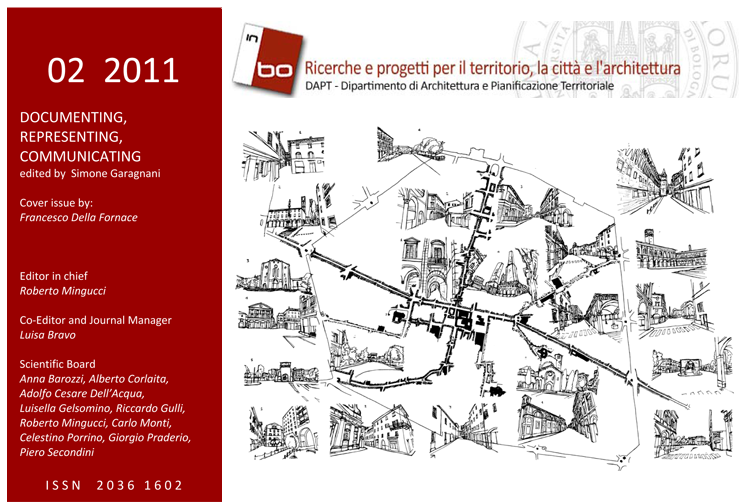 Vol. 2 No. 2 (2011)DOCUMENTING, REPRESENTING, COMMUNICATING
Vol. 2 No. 2 (2011)DOCUMENTING, REPRESENTING, COMMUNICATINGThis issue is devoted to the fundamental themes of representation and communication intended as disciplines of architecture and planning at the different scales of buildings and urban territory.
"Telling" the space, but even more representing the emotions that space itself communicates, thus becomes a kind of documentation which converges different knowledge no longer bound to a single discipline or a single aspect of culture, reconfiguring the real as the synthesis of 'human essence.Here are the premises for this IN_BO issue, presenting interesting contributions such as M. Beatrice Bettazzi’s one, where the history of architecture, inspired by frescoes depicting the urban landscape, fades into the broader territory of mental structures, cognitions and cultural processes, intended as man’s perceptions about space, its design and its way of living.
The very perception is the fulcrum of this spatial empathy: visual emotions, as "told" by the stereoscopic graphics, architecture and focus on the centrality of man in his presence, in the words of Alessandro Rigolon, connect seamlessly the feelings of memory and absence, as can be appreciated in themes addressed by Mariana Nitu, who died prematurely and is remembered here by Luigi Bartolomei.
Following more technical approaches, alternate with elegance in a cultural continuum leitmotif of the number, the architectural perceptions and teachings techniques are covered in the atlas of restoration by Francesco Conserva too, together with considerations about urban design by E. Elisabetta Minghini, or the story telling par-excellence, drawing, declined by Luisa Bravo in the representation of cities and urban sequences.Edited by Simone Garagnani
-
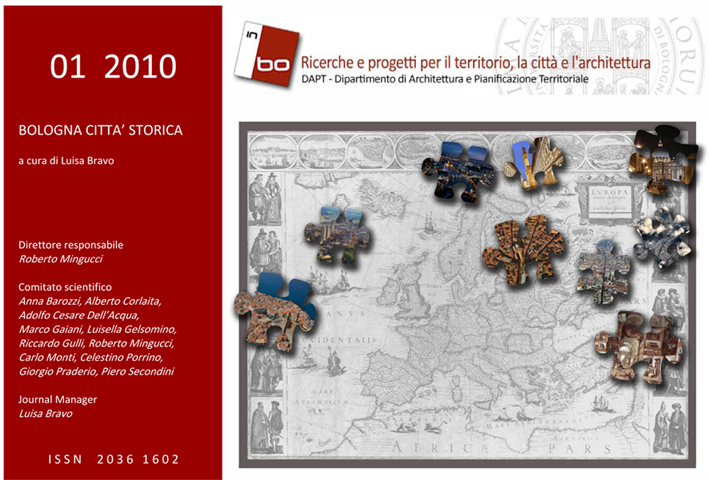 Vol. 1 No. 1 (2010)BOLOGNA HISTORIC CITY
Vol. 1 No. 1 (2010)BOLOGNA HISTORIC CITYIn 1970 the Municipality of Bologna published the book "Bologna centro storico", which included methodologies and criteria that had guided the plan of conservation of the historical center, approved in 1969, along with analysis and insights on the city, such as photographical census, morphological, typological and sociological studies. A wide, documented, persuasive survey, in order not to freeze a situation, considered permanent, but to create, on the contrary, "an ancient city for a new society", as defined by Pier Luigi Cervellati. The book accompanied an exhibition with the same title at Palazzo d'Accursio, where drawings of the Plan were exhibited, in a careful process of communication and publication towards citizens.
The city of Bologna has the great merit to have pursued, during the twentieth century, good management practices and land development, so that it can be considered, in a local sense, as a virtuous example of urban governance and, in a national level, as the site of cultural ferment for discipline urbanism. Forty years later, the launch of a forum of discussion on the historic city of Bologna is the opportunity for critical reflections regarding contents and methodology of the Plan and the outcomes of its applications in the urban context, in order to promote, from the project "Bologna centro storico", the vision of a" Bologna città storica", renewed and adapted to contemporary.
The first part of the issue, in the HISTORIC CITIES section, contains the proceedings of the conference held on 10-11 December 2009 in Bologna, at the Faculty of Engineering, promoted by the Department of Architecture and Territorial Planning and by the Doctorate Course in Building and Territorial Engineering at University of Bologna. The event was developed under the patronage of the Institute of Cultural Heritage of the Emilia-Romagna Region. http://www.ibc.regione.emilia-romagna.it/wcm/ibc/eventi/cittastoricheconvegno.htm.
The second part of the issue, in the FORUM section, contains the results of the discussion forum, developed after the conference, during 2010, among various stakeholders. The Forum is intended to be the the starting step of a process, wider and more structured, gathering critical issues, ideas and guidelines regarding the historic city, at different levels, from researchers, city users and citizens, in order to identify possible actions to upgrade, evaluation and renovation historical values.Edited by Luisa Bravo





